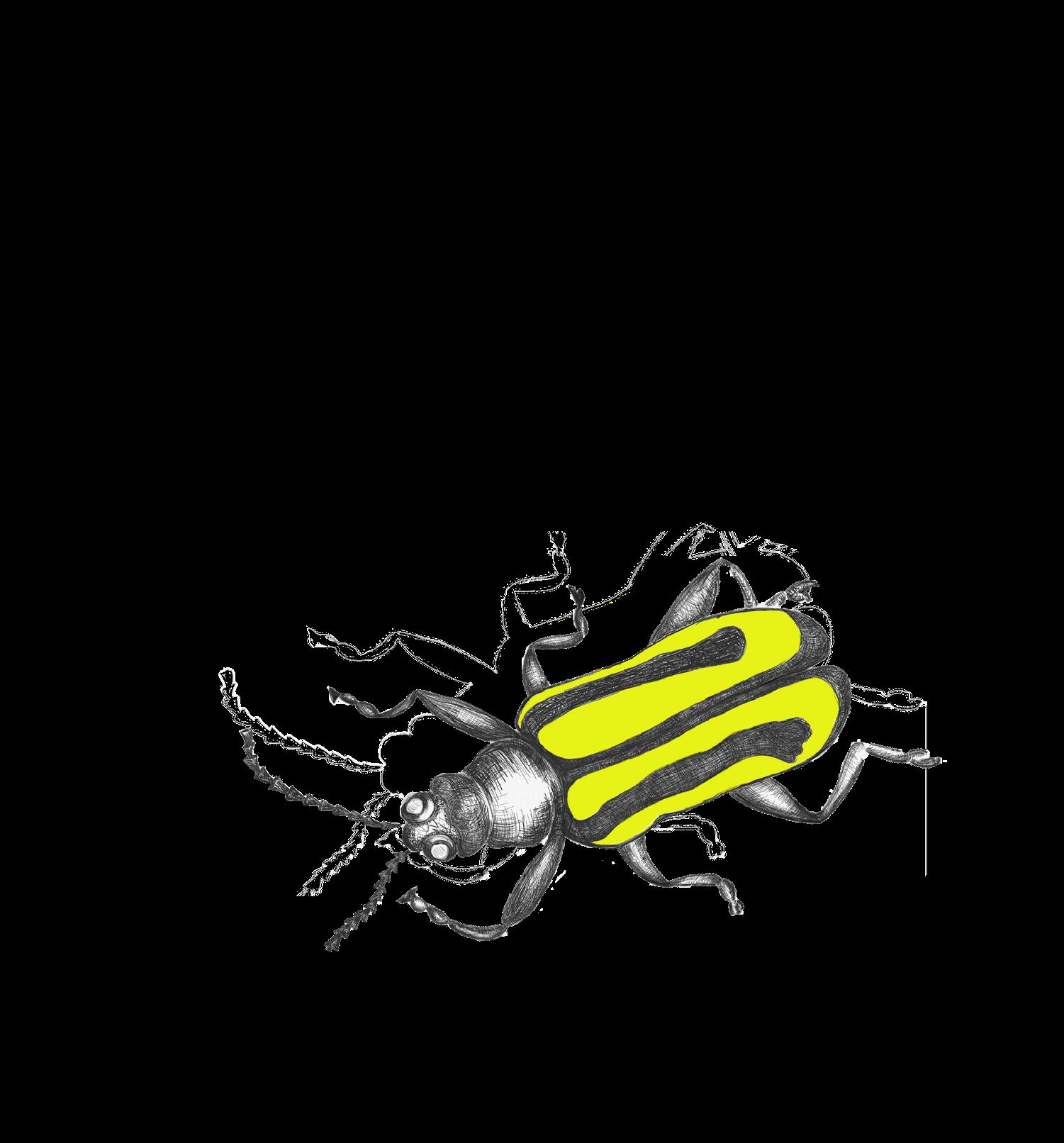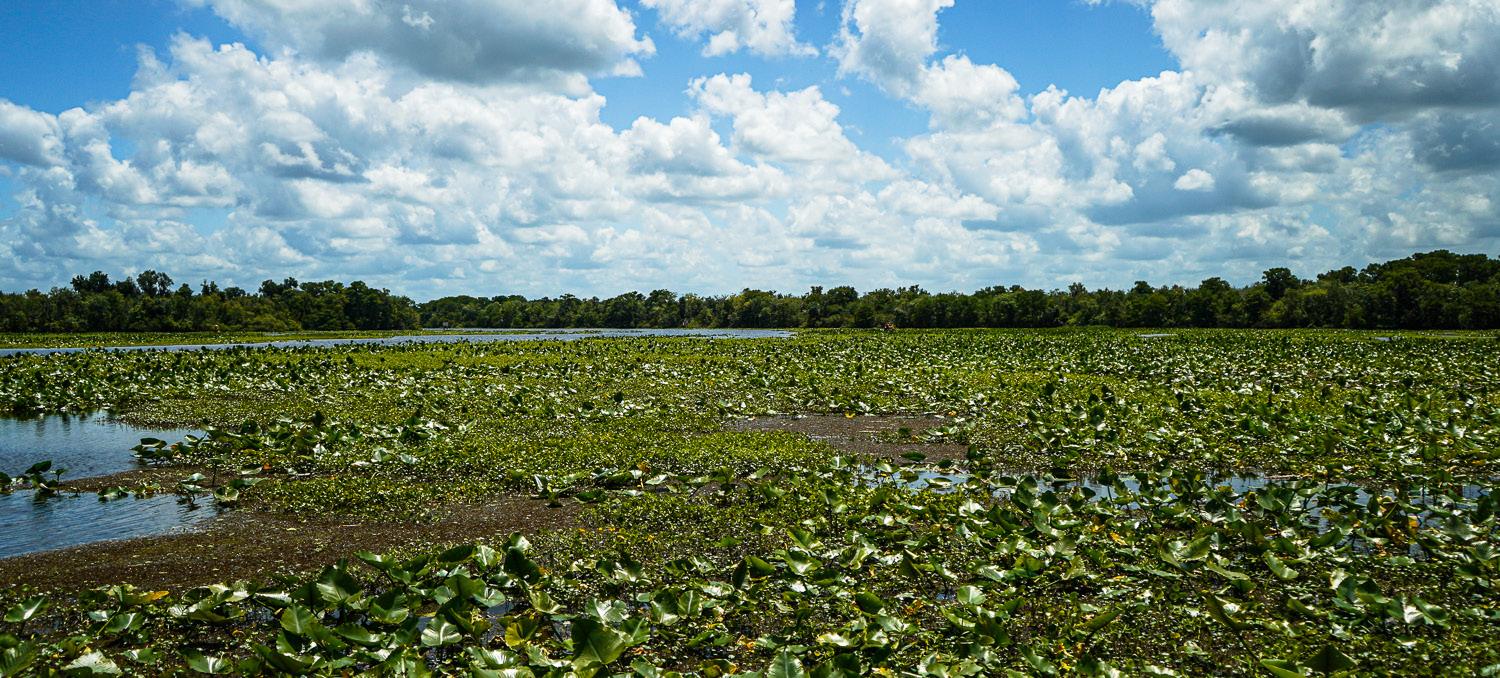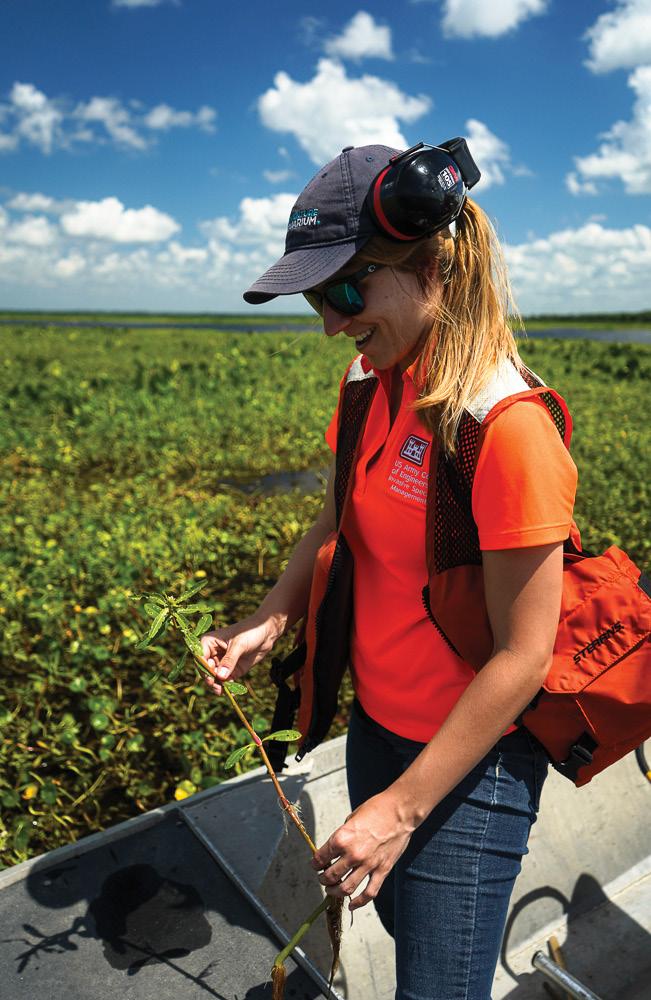
6 minute read
The Corps’ Tiny Weapon
Winning the CORPS’TINY WEAPON
BIO CONTROL BATTLE Brigida Sanchez
Advertisement
Bathed in sunscreen and bug spray, a U.S. Army Corps of Engineers team sets out early in the morning with cloth nets, coolers and airboats hitched up to their pickuptrucks. Their mission is to collect the Corps’ tiniest weapon used to wage war on the prolific alligator weed. “In the 1900s alligator weed was introduced into the continental United States says Chelsea Bohaty, a biologist with the U.S. Army Corps of Engineers. “It caused a lot of problems in the waterways with plants blocking navigation channels and flood risk management problems.” Alligator weed kills native flora and fauna. The root system of the plant travels down into the water column, not allowing the water to receive the oxygen it needs to conserve its natural ecosystem. “In the ’60s the U.S. Army Corps of Engineers understood the impacts of the invasive species. We focused a lot of our treatment toward the alligator weed, and we spent a great deal of money on treating the plant. The alligator flea beetle was a game-changer,” explains Bohaty. The Corps would spend more than $1 million on managing the environmental impacts of the alligator weed in a given year. Invasive species cause economic losses of more than $138 billion in the U.S. annually. Utilizing a strategy called Integrated Pest Management (IPM), scientists employ a combination of biological, mechanical and chemical control measures to mitigate the impacts of the invasive plant species. Biocontrol agents such as the herbivorous alligator flea beetle go through years of rigorous research.

Biologists have to determine if the tiny agent will cause adverse impacts to plants and animals in the U.S. “The alligator flea beetle is a classic success story for aquatic weed biocontrol,“ says Nathan Harms, a research biologist at U.S. Army Engineering Research and Development Center (ERDC). “There are a couple of things that make it such a good agent. First, both the adults and the larvae feed on the plant. The adults can live a long time, for one to two months, and the female can lay thousands of eggs. So a couple of fecund (productive) females with a short developmental time in all life stages consuming the plant are effective.” This little beetle measures 5-7 millimeter in length as an adult. Its name, the flea beetle, is an attribution to its flea-like jumping capabilities. Under the right environmental conditions, the alligator flea beetle can make a significant impact. According to the University of Florida’s Entomology and Nematology Department, the alligator flea beetle once fully established can decimate an acre mat of the alligator weed. “The beetle has already established itself in Florida. They are doing their job out there right now,” says Bohaty, who coordinates and participates in the collection of the beetles. She is the lead biologist on the Corps Palatka team. On this particular morning, the collection takes place on Lake Woodruff with five airboats flying swiftly through the water to each mat of alligator weed. Each boat goes to a designated location where the vivacious beetles have been scouted out previously
feasting on the alligator weed. There’s a small craft operator and a collector aboard when they reach the mat of alligator weed. The collector stands on the bow of the airboat as it slowly plows through the invasive plants. The disturbance of the craft moving through the green carpet of vegitation sends thousands upon thousands of little flea beetles flying through the air. The nimble collectors sweep their nets back and forth, catching the beetles in the cloth. When enough beetles have been collected, they are placed in cups with some alligator weed and stored in a cooler. Bohaty says, “We can typically collect anywhere from 10,000 to 50,000 beetles a day.” So where do all these beetles go? They get shipped to Louisiana, Alabama, Arkansas and as far north as North Carolina to our partners: state and federal agencies, Corps districts, universities and ERDC. These partners not only study the alligator weed, but the beetle as well. ERDC serves as a nucleus of

knowledge for the Corps far-flung districts. “We have a valuable resource here at ERDC. We have a genetic diversity of all the alligator weed that is present in the U.S.,” explains Harms. “And it lets us address questions about how the flea beetles might work and how they might control alligator weed given its introduction into different parts of the country.” Jacksonville, Fla., has the right climate to sustain the reproduction of the flea beetles. It is the perfect place to monitor the effects of generations of biocontrol and the ideal place to collect new beetles and send them to places like the Little Rock District in Arkansas, where the alligator weed is aggressively taking over. At the U.S. Army Corps of Engineers, Little Rock District, biologists like Cherrie Lee Phillips take the beetles back out into the waters of Arkansas. Using an airboat, they collect alligator weed samples, demark areas to observe both the alligator weed and the beetle, and place the hibernating beetles onto a mat of alligator weed.

U.S. Army Corps of Engineers’ Mark Haltiwanger (from left), Will Goodhart and Chelsea Bohaty, collect dozens of tiny alligator flea beetles in nets. The beetles feed on the invasive aquatic alligator weed found in Lake Woodruff, in Deland, Fla. Photo: Brigida Sanchez
The alligator weed has invaded many water systems in the South and is slowly working its way to north and west through the continental United States. This noxious weed blocks transportation routes, threatens native species and reduces water capacity in our reservoirs. Photo: Brigida Sanchez




“When we get beetles, we get 250 beetles per cup, and that one cup will cover one acre of the alligator weed,” says Phillips. “Here at Millwood Lake, we have approximately a 1,000 acres (of alligator weed), but that varies year to year depending on the temperature.” The cooperation between the district and ERDC is just one of the many collaborative efforts that the Corps participates in to help advance the study of the aquatic invasive itself. Researchers want to know: How does the plant evolve, and once introduced how does it spread into an area? The study also aids with finding the most efficient and sustainable ways to use the alligator flea beetle, especially when colder climates and plant variations become a factor. The Corps is continuously evolving to combat the challenges of the invasive species problem. We embrace the philosophy of early detection, rapid response, and finding the best strategies with the least amount of environmental impact. We understand that complete eradication of an invasive species may not be possible. But by using the Corps collective knowledge, we can employ the best methods to manage the aggressive nonnative species that threaten the native ecosystems and our economy. Chelsea Bohaty, invasive species management biologist, holds the invasive aquatic alligator weed found in Lake Woodruff.
The U.S. Army Corps of Engineers, Jacksonville District, delivers value to the nation by anticipating needs and collaboratively engineering solutions that support national security, energize our economy and increase resiliency.










